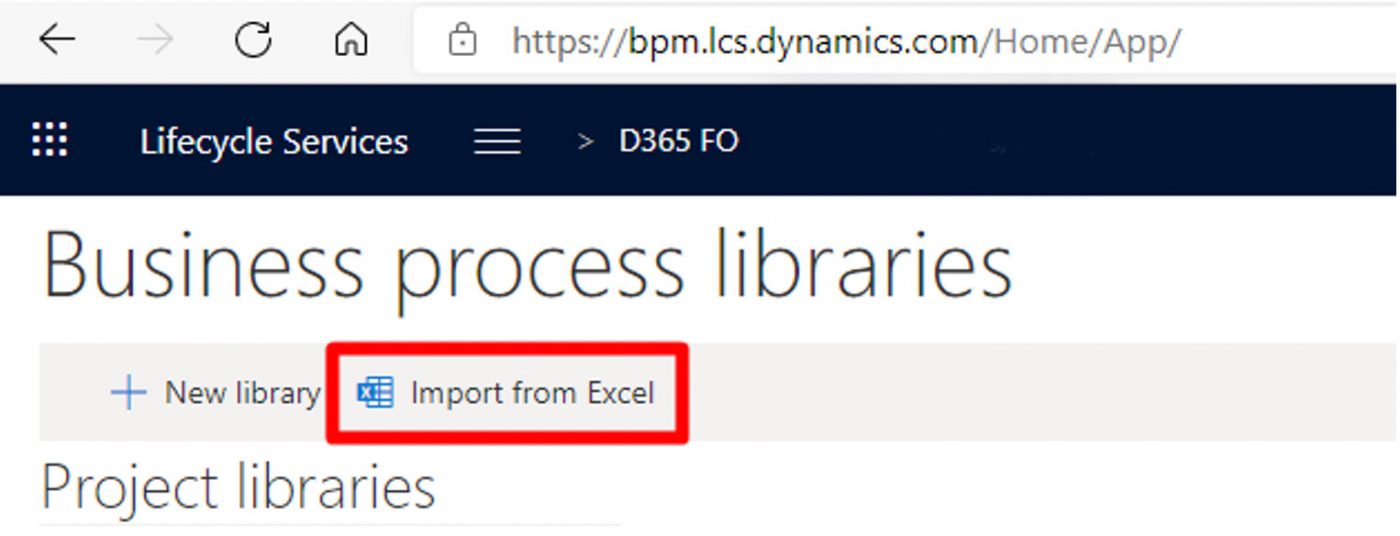In this article I would like to tell you about my experience creating a project library in Business Process Modeler (BPM). There are two ways to add processes to the project library. The first one is manually, creating the tasks one by one and writing on them the name of the process and its description. The other way is to import an Excel template in which we previously have these fields. The latter is the one I wanted to learn and implement.
BPM is a tool offered by Microsoft through Lifecycle Services (LCS) which allows us to use the discipline also called BPM. With this we can control, execute, measure and optimise our business processes thanks to project libraries, tasks and task recordings.
The first thing to do (once the Fit & Gap document has been prepared) is to download the import template. To do this, go to BPM and click on Import from Excel:

Next, a pop-up window will open, asking us to give a name to the library and we will have a browser to load the file, but we will leave that for later. From this window we are interested in the click that allows us to download template:

The header of this Excel document will consist of the following columns: Id / Parent Id / Process Name / Process Description / Group / Usage Profile 7/ Industry / Region , but of these we are only interested in the first four.

The definition of these fields is as follows:
• This field must start with the number 100 and be constant from the first to the last process. This will allow us to give a numerical identification to each process and thus define which processes depend on other processes (the so-called “child”).
• Parent Id: This field gives sense to the previous one. It defines the “parent” of a process, or the process on which the line we are working on depends. This is the most important of our document, since it will define the hierarchy of our library.
• Process Name: In this field we must show the name of the process and, if applicable, the GAP code.
• Process Description: A short description of the process or, again, the name of the process.
In this example we are going to import few processes, and these processes will be simple to make it clear. Our library will consist of the following scope:

Let’s suppose that this will be the scope of our project and this is how we want it to look in BPM. The first thing we need to do is to transfer it to our downloaded template in the following way:
• The column # together with the Description will become part of the Process Name and Process Description in the template through the Excel concatenation formula.
• The Group column will become part of the subgroups from which the processes will hang, and in turn, these subgroups will hang from the main groups (General Ledger, Taxes, Cash Management and Banks, Fixed Assets, Suppliers, Customers, etc.).
The groups and subgroups are listed in the following in their corresponding order:

The groups and subgroups are listed in the following in their corresponding order:

Next, we complete the Id column starting with the number 100 and in ascending order:

Finally, it is time to complete the Parent Id column.
1. GENERAL ACCOUNTING
2. TAXES
3. CASH MANAGEMENT AND BANKING
4. FIXED ASSETS
5. SUPPLIERS
6. CUSTOMERES
should not have any Parent Id, as there is no process in the hierarchy on which they hang.
On the other hand, subgroups such as 1.1. PRINCIPAL ACCOUNTS will depend on the above mentioned groups, and in turn, processes such as 1.1.1. Create Accounting Account will hang from the subgroups.
The final result of the template should be as follows:

Once we have the completed template we must go back to the pop-up window we opened to download it. In this window we choose the filled file and import it.

The result of this will be as follows:

And the next, once deployed:

I hope you have been useful. I’ll tell you more about Business Process Modeler later.




